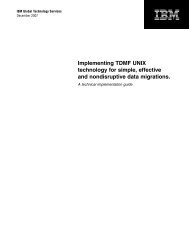The evolving role of the CIO - IBM
The evolving role of the CIO - IBM
The evolving role of the CIO - IBM
You also want an ePaper? Increase the reach of your titles
YUMPU automatically turns print PDFs into web optimized ePapers that Google loves.
But <strong>the</strong> recent vogue that has suggested that <strong>CIO</strong>s can<br />
leave <strong>the</strong> IT content to <strong>the</strong>ir Chief Technology Officers<br />
or equivalent has been found wanting. Continuing<br />
technological development in such diverse areas as<br />
service oriented architecture, business intelligence,<br />
security, Web services, ‘greening’ <strong>of</strong> IT, and multichannel<br />
customer service demand an understanding <strong>of</strong> <strong>the</strong><br />
associated technology issues, impacts and opportunities.<br />
Add this to <strong>the</strong> constantly swinging technology pendulum<br />
(for example, centralisation decentralisation <strong>of</strong><br />
processing power and storage) and it is clear that <strong>CIO</strong>s will<br />
continue to need strong IT roots connected with knowledge<br />
<strong>of</strong> contemporary IT developments and opportunities.<br />
<strong>The</strong>ir problem-solving skills need to be acute. <strong>The</strong> <strong>CIO</strong> has<br />
to be able to ask <strong>the</strong> right questions <strong>of</strong> <strong>the</strong> team, and <strong>of</strong>ten<br />
has to be on call virtually 24 hours a day, seven days a<br />
week to trouble-shoot problems and keep business-critical<br />
systems in operation.<br />
In <strong>the</strong> old days, it was simply a matter <strong>of</strong> keeping IT<br />
projects on time and on budget – but today, <strong>the</strong> <strong>CIO</strong> has<br />
to be active across every aspect <strong>of</strong> complex investment<br />
programmes which can cost millions <strong>of</strong> pounds. Stakeholder<br />
management skills are crucial in <strong>the</strong> <strong>of</strong>fice, as <strong>the</strong> <strong>CIO</strong> tries<br />
to persuade and influence colleagues to support policies<br />
within <strong>the</strong> new, wider portfolio <strong>of</strong> responsibilities; and strong<br />
programme management skills are needed to ensure that<br />
investment programmes are not just on time and on budget,<br />
but also on target – that <strong>the</strong>y deliver <strong>the</strong> value expected by<br />
<strong>the</strong> organisation.<br />
All this adds up to a commitment to long-term, strategic<br />
business planning – so it is hardly surprising that <strong>the</strong><br />
average time for a <strong>CIO</strong> to remain in post is currently around<br />
six years 1 . That, incidently, may be nearly twice as long as<br />
<strong>the</strong> average CEO.<br />
So modern <strong>CIO</strong>s find <strong>the</strong>mselves in a long-term, responsible,<br />
strategic and business-oriented <strong>role</strong>. How do <strong>the</strong>y position<br />
<strong>the</strong>mselves to take on <strong>the</strong> job? What does it take to buy<br />
a ticket on <strong>the</strong> <strong>CIO</strong>s’ train?<br />
What does it take?<br />
Today’s <strong>CIO</strong>s still have technological skills, most being<br />
educated in scientific or engineering disciplines, with<br />
a career background which has brought <strong>the</strong>m from<br />
programming and data processing origins through various<br />
IT management <strong>role</strong>s. Ano<strong>the</strong>r common route to <strong>the</strong> <strong>CIO</strong>’s<br />
1 <strong>CIO</strong> Insight, Allan Alter, April 2006.<br />
<strong>of</strong>fice is through IT cost management and cost control,<br />
as CEOs and CFOs look for someone who will be ruthless<br />
and meticulous in chasing down cost overruns.<br />
So technological and IT awareness remains crucially<br />
important. Maybe surprisingly, in terms <strong>of</strong> qualifications,<br />
less than a third have completed any advanced business<br />
studies such as an MBA – but <strong>the</strong>y do have a clear<br />
business track record. Less than half <strong>of</strong> today’s <strong>CIO</strong>s<br />
have a background which is solely or mostly in <strong>the</strong><br />
technological area 2 .<br />
Many <strong>CIO</strong>s have changed <strong>the</strong>ir philosophy in order to fit<br />
in with <strong>the</strong>se new demands. In <strong>the</strong> old days, when <strong>the</strong> job<br />
was overwhelmingly technical, <strong>the</strong>y had to be risk-averse,<br />
black-and-white – maybe even slightly unimaginative.<br />
That was fine <strong>the</strong>n – but today, when it is about dealing with<br />
people and developing an overall management approach,<br />
<strong>the</strong>y need <strong>the</strong> ability to make decisions based on whatever<br />
information is available at <strong>the</strong> time. As <strong>the</strong> chart shows,<br />
<strong>the</strong> <strong>CIO</strong> is increasingly involved not just in providing<br />
information, but in creating <strong>the</strong> business strategy. That<br />
calls for extensive insight and experience, for business<br />
skills and a business attitude as well as <strong>the</strong> ability to<br />
interpret information.<br />
Primary <strong>role</strong> in company strategic decision making<br />
50%<br />
40%<br />
30%<br />
20%<br />
10%<br />
0%<br />
26%<br />
Implement<br />
<strong>the</strong><br />
strategy<br />
17%<br />
Provide<br />
input to <strong>the</strong><br />
strategy<br />
As a result <strong>of</strong> all <strong>the</strong>se developments, <strong>the</strong> relationship<br />
between <strong>the</strong> <strong>CIO</strong> and <strong>the</strong> CEO has changed dramatically.<br />
From <strong>the</strong> CEO’s side, <strong>the</strong>re is still a need to consult and<br />
confide in someone who has an impressive knowledge base<br />
in <strong>the</strong> technological side <strong>of</strong> IT – but today, he or she is also<br />
looking for someone who also understands <strong>the</strong> key business<br />
imperatives <strong>of</strong> <strong>the</strong> organisation.<br />
43%<br />
Participate<br />
in creating<br />
<strong>the</strong> strategy<br />
Source: <strong>IBM</strong> <strong>CIO</strong> Leadership Forum Survey 2006.<br />
14%<br />
Shape <strong>the</strong><br />
strategic<br />
options being<br />
considered<br />
2 Setting <strong>the</strong> Innovation Agenda: <strong>the</strong> <strong>IBM</strong> Leadership Forum Summary Dec 2006.

















